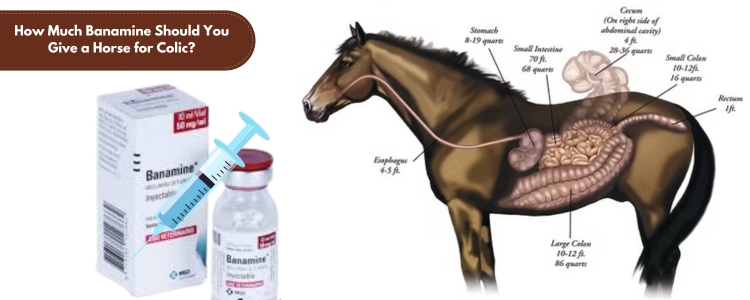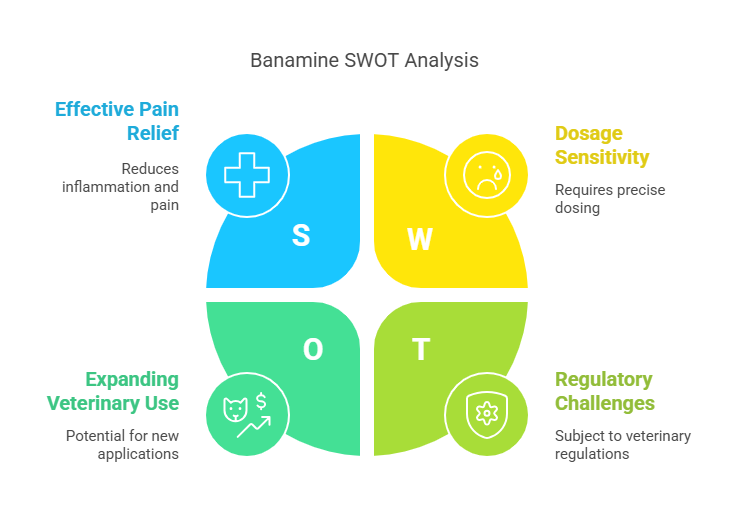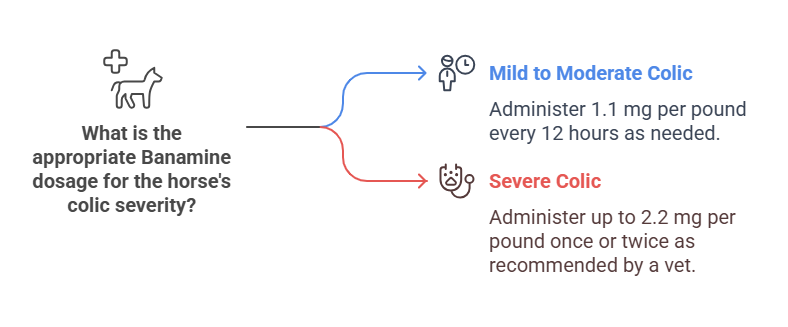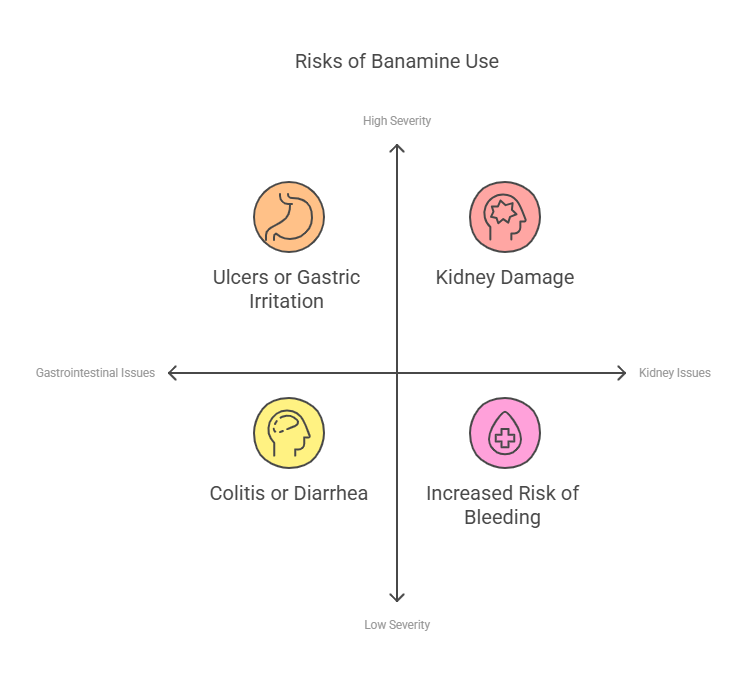The recommended dosage of Banamine (flunixin meglumine) for a horse with colic is typically 0.5 to 1.1 mg per pound of body weight, administered either intravenously (IV) or intramuscularly (IM). This dosage is usually given every 12 to 24 hours, depending on the severity of the symptoms. Colic is a common yet serious condition that affects horses, causing severe abdominal pain. The pain can stem from a variety of issues, including gas, impaction, or even twisted intestines. When a horse experiences colic, it is crucial to treat the condition quickly and effectively to avoid further complications or even death.
One of the most commonly used medications for colic is Banamine. This drug is a non-steroidal anti-inflammatory drug (NSAID) that helps relieve pain, reduce inflammation, and lower fever. As a horse owner or caretaker, understanding the proper dosage of Banamine is essential for your horse’s health.
This guide will answer your questions about how much Banamine to give a horse for colic, including dosage recommendations, when to seek professional help, and important safety information.
What Is Banamine?
Banamine is a brand name for flunixin meglumine, a type of NSAID. It is widely used in veterinary medicine to treat various conditions in horses, including colic, musculoskeletal pain, and inflammation. Its ability to reduce inflammation and pain makes it effective in managing colic symptoms, especially when given at the correct dosage.
How Does Banamine Help with Colic?
Colic can cause a variety of symptoms, including abdominal discomfort, bloating, and difficulty passing gas or stool. Banamine works by reducing the inflammation in the gastrointestinal tract and alleviating pain, which can provide relief for horses suffering from colic. The drug acts quickly, making it an essential treatment in managing this painful condition.
How Much Banamine Should You Give a Horse for Colic?
The correct dosage of Banamine varies depending on the size and weight of the horse. On average, the typical dose for adult horses is between 1.1 to 2.2 mg per pound (2.2 to 4.4 mg per kg) of body weight. This dosage can be administered intravenously or intramuscularly.
However, it is important to note that you should always follow the recommendations of your veterinarian when administering Banamine to a horse, as they can provide personalized dosage information based on your horse’s specific needs.
Banamine Dosage Guidelines
- For Mild to Moderate Colic: Administer 1.1 mg per pound of the horse’s body weight. This can be done every 12 hours, if necessary, depending on the horse’s response to the medication.
- For Severe Colic: In some cases, your vet may recommend up to 2.2 mg per pound of the horse’s body weight. This higher dosage may be administered once or twice depending on the severity of the condition.
Always ensure you have the correct dosage and consult with a veterinarian before giving the medication.
Administration Methods
- Intravenous (IV) Injection: The fastest way for Banamine to take effect is through an IV injection. This method is typically preferred for severe colic cases, as it provides rapid relief.
- Intramuscular (IM) Injection: For less severe cases, Banamine can also be injected into the muscle. This method is effective but slower than IV administration.
- Oral Paste: In some cases, Banamine may be available as an oral paste. This is often used for milder colic cases but may not act as quickly as an injectable form.
Signs Your Horse Needs Banamine
Knowing when to administer Banamine can be tricky. While you should always consult a veterinarian if you’re unsure, certain signs may indicate that your horse is suffering from colic and could benefit from Banamine:
- Pawing at the Ground: Horses often paw at the ground when they are in pain, particularly from abdominal discomfort.
- Rolling or Lying Down Frequently: Horses experiencing colic may try to lie down, roll, or stand up repeatedly due to pain.
- Bloating or Distended Abdomen: Swelling or bloating in the horse’s stomach can indicate gastrointestinal distress.
- Reduced Appetite or Lack of Drinking Water: Colicky horses often lose their appetite and may refuse to drink water.
- Restlessness: A horse in pain may seem more agitated or restless than usual.
Risks and Side Effects of Banamine
While Banamine is an effective treatment for colic, it comes with risks, especially when used incorrectly. Some potential side effects include:
- Ulcers or Gastric Irritation: Long-term use or overuse of NSAIDs like Banamine can irritate the stomach lining and lead to ulcers.
- Kidney Damage: High doses of Banamine or prolonged use can put stress on the kidneys, especially in dehydrated horses.
- Colitis or Diarrhea: Banamine can alter gut motility, potentially leading to diarrhea or other gastrointestinal issues.
- Increased Risk of Bleeding: NSAIDs can interfere with blood clotting, which may increase the risk of bleeding during surgery or trauma.
Because of these risks, Banamine should be used sparingly and under the guidance of a veterinarian. Overuse can lead to significant health problems.
When to Seek Veterinary Help
Even though Banamine can help manage colic pain, it is crucial to seek professional help if your horse does not show signs of improvement after receiving the medication. Colic can be caused by various issues, some of which are life-threatening. Conditions like gut torsion, intestinal strangulation, or severe impaction require immediate veterinary intervention.
If your horse is showing symptoms of colic and is not improving after Banamine treatment, it is time to contact a veterinarian. In some cases, surgery or other treatments may be necessary.
Alternatives to Banamine for Treating Colic
While Banamine is a widely used treatment for colic, it is not the only option. Other pain relief medications that can be used for colic include:
- Flunixin Meglumine (Generic Banamine): The generic version of Banamine may also be used, and it can be just as effective as the branded product.
- Phenylbutazone (Bute): This NSAID is commonly used for musculoskeletal pain and is sometimes used for colic in horses.
- Pain Relief Supplements: Certain herbal or dietary supplements may help alleviate mild colic symptoms, although they should not replace proper veterinary care.
Your veterinarian will help determine the most appropriate treatment for your horse’s colic based on the severity and underlying cause.
FAQ: How Much Banamine to Give a Horse for Colic
1. Can I give Banamine to my horse without a vet’s recommendation?
It is always best to consult a veterinarian before giving Banamine to your horse, especially since incorrect dosages can cause harm.
2. How often can I administer Banamine for colic?
Banamine can typically be given every 12 to 24 hours, depending on the severity of the colic and the horse’s response to the medication. However, never exceed the recommended dosage without consulting a vet.
3. Can Banamine be given orally for colic?
Yes, Banamine can be administered as an oral paste. However, the injectable form is usually more effective for immediate relief.
4. How do I know if my horse’s colic is severe enough for Banamine?
Severe colic symptoms, such as constant rolling, inability to pass stool, bloating, and persistent pain, often require Banamine treatment. Always seek professional advice.
5. Is there any risk with long-term Banamine use for colic?
Yes, prolonged use of Banamine can cause gastrointestinal ulcers, kidney damage, and other side effects. Always follow your vet’s instructions and avoid long-term use.
Bottom Line
Administering Banamine to a horse for colic can provide immediate relief from abdominal pain, but it is essential to follow proper dosage guidelines. Always consult a veterinarian for personalized recommendations based on your horse’s condition. While Banamine can be a life-saving treatment, its use should be carefully monitored to avoid side effects or complications.




